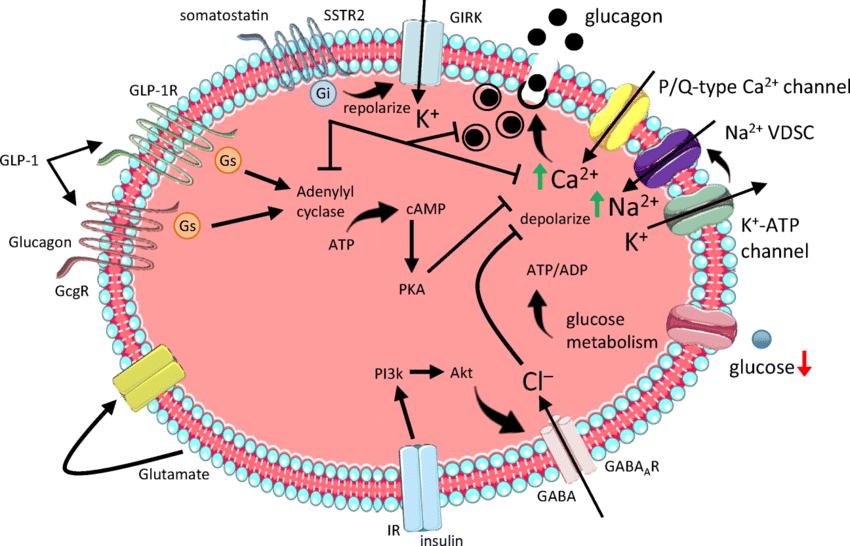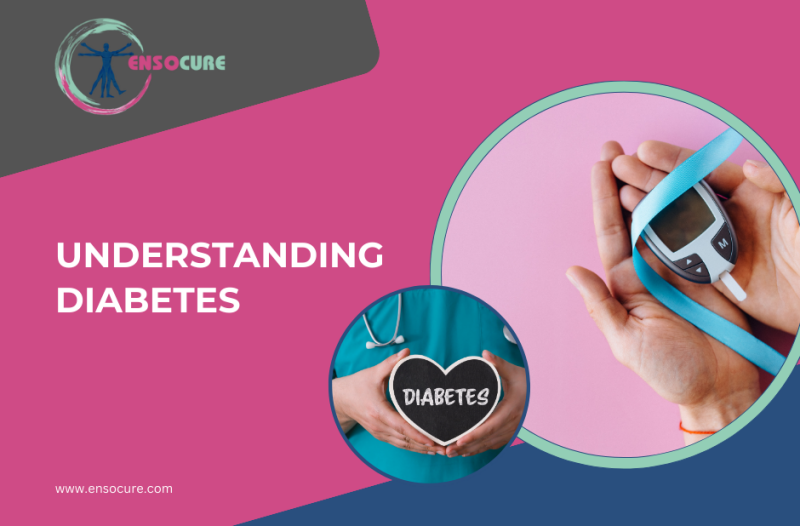According to the International Diabetes Federation (IDF), approximately 415 million adults between the ages of 20 to 79 years had diabetes mellitus in 2015. DM is proving to be a global public health burden as this number is expected to rise to another 200 million by 2040. According to a 2022 Lancet study, 101 million people in India – 11.4% of the country’s population – are living with diabetes. A survey commissioned by the health ministry also found that 136 million people – or 15.3% of the people – could be living with pre-diabetes.
Diabetes is a chronic metabolic disorder which occurs when the body is unable to effectively regulate blood sugar levels, leading to a range of health complications. To comprehend diabetes, it’s crucial to study the role of insulin, the hormone central to glucose metabolism, and understand the distinctions between type 1 diabetes, type 2 diabetes, and pre-diabetes. Before knowing the types of diabetes, one needs to understand the endocrine function of the pancreas, and the storage of sugar in your body right from the time you eat.
Glucose Metabolism, Production and Storage
When you eat, the sugar from carbohydrates is converted into glucose in the liver. This glucose is utilized in the body with the help of pancreatic function. The excess glucose is then converted into glycogen which is stored in the liver and muscles. When there is no space to store anymore glucose, the body the stores the excess glucose as lipids in your fat cells. This is why excess sugar means more fat.
To utilize glycogen, and help in utilizing glucose for energy, the pancreas is called upon to do its job by secreting two hormones insulin and glucagon.
What Is the Difference Between Glucagon and Insulin?
Glucagon and insulin are both important hormones produced by the pancreas to regulate your blood glucose (sugar). Alpha cells in the pancreas produce and release glucagon, while beta cells in the pancreas produce and release insulin. Glucagon increases blood sugar levels, whereas insulin decreases blood sugar levels. Lack of insulin or when it isn’t utilized properly by your body can lead to high blood sugar (hyperglycemia), or diabetes.
Glucagon

Glucagon prevents your blood sugar from dropping too low. Whenever the pancreas detects a significant drop during fasting, exercise and other causes, it releases glucagon. Glucagon then signals the liver to release stored glycogen into glucose so that the body can use it for energy. Glucagon can also prevent your liver from taking in and storing glucose so that more glucose stays in your blood. Glucagon can also make glucose from other sources, such as amino acids.
What is Insulin

Insulin acts as the key to opening your cells to allow glucose to enter. When blood sugar levels rise, the pancreas detects this increase and releases insulin into the bloodstream. The release of insulin is triggered by the presence of glucose and other factors such as hormones and nerve signals.
In the insulin process, every cell has insulin receptors on its surface. When insulin binds to these receptors, it signals the cell to transport glucose from the bloodstream into the cell’s interior. Once inside the cell, glucose is converted to energy by the help of mitochondria or the cell’s batteries through a process called cellular respiration. Chemical energy produced by the mitochondria is stored in a small molecule called adenosine triphosphate (ATP). At any given time, there are about 250 g of ATP in the cells. This represents about 4.25 watts, the equivalent of the energy in an AA battery.
When the cells have used enough sugar, and if there is an excessive amount, insulin signals the liver and muscle cells to convert excess glucose into glycogen for later use.
Type 1 Diabetes
Type 1 Diabetes: An autoimmune disorder with the immune system mistakingly attacks and destroys the insulin-producing beta cells in the pancreas. The lack of insulin in type 1 diabetes leads to high blood sugar levels, requiring external insulin administration for survival.
Type 1 diabetes was at one time known as insulin-dependent or juvenile diabetes. It usually develops in children, teens, and young adults, but it can happen at any age. Research is still on to find what causes Type 1 DM. Scientists think type 1 diabetes is caused by genes and environmental factors, such as viruses, that might trigger the disease. There is no cure till date, except insulin administration, monitoring and effective management.
Type 2 Diabetes and Insulin Resistance
Type 2 diabetes is also called insulin resistance and accounts for around 90% of all cases of DM in the world. In Type 2 diabetes, your cells refuse to let insulin unlock them, they become insulin resistant leading to increased sugar levels in the blood. The Pancreas then works overtime producing more insulin Eventually the cells in the pancreas that make insulin get damaged and can’t make enough insulin to meet the body’s needs. T2DM usually affects persons older than 45 years, but is now being seen in children, adolescents, and younger adults due to rising levels of obesity, physical inactivity, and unhealthy diets.
Causes Of Type 2 Diabetes
- Unhealthy lifestyle & Diet
- Excessive consumption of processed food, and unhealthy carbs containing refined sugar
- Obesity
- No physical exercise
- PCOS
- Genetics
- High blood pressure
- Age
- Blood Lipids
- Prediabetes
- Sleep disorders
- Stress
Symptoms of Diabetes
- Excessive Thirst (Polydipsia)
- Frequent Urination (Polyuria)
- Unexplained Weight Loss
- Increased Hunger (Polyphagia)
- Fatigue and Weakness
- Blurred Vision
- Irritability and Mood Changes
- Frequent Infections
- Slow Healing of Wounds
Medication and Treatment
Managing type 2 diabetes often involves a combination of dietary modifications, regular physical activity, maintaining a healthy weight, oral medications, and in some cases, insulin therapy. Lifestyle changes can even prevent the risk of type 2 diabetes and are key to managing blood sugar levels effectively, preventing complications like heart disease, nerve damage, and kidney problems.
In India there is range of medication for type 2 diabetes prescribed depending on an individual’s age, blood sugar levels, and various other conditions. Never take your own medication and always consult your doctor.
Prediabetes
Prediabetes is a condition when your blood sugar levels are higher than normal, but not yet high enough to be classified as type 2 diabetes. Prediabetes a WARNING sign indicating your body is at risk of developing type 2 diabetes in the future. Don’t take prediabetes lightly, treat it as an opportunity to make lifestyle changes that will prevent or delay the progression to type 2 diabetes.
What Is Prediabetes?
In prediabetes, the body’s cells become less responsive to insulin (insulin resistance), and the pancreas may struggle to produce enough insulin to keep blood sugar levels within a healthy range. This results in slightly elevated blood sugar levels, which are typically measured through the fasting plasma glucose (FPG) test, the oral glucose tolerance test (OGTT), or the hemoglobin A1c (HbA1c) test.
Signs & Symptoms
- Being overweight
- Being 45 years or older
- Having a parent, brother, or sister with type 2 diabetes
- Being physically active less than 3 times a week
- Ever having gestational diabetes (diabetes during pregnancy) or giving birth to a baby who weighed more than 9 pounds
- Having polycystic ovary syndrome
Key Diagnostic Criteria for Prediabetes:
- Fasting Plasma Glucose (FPG): Fasting blood sugar levels between 100 mg/dL (5.6 mmol/L) and 125 mg/dL (6.9 mmol/L) indicate prediabetes.
- Oral Glucose Tolerance Test (OGTT): After drinking a sugary solution, blood sugar levels between 140 mg/dL (7.8 mmol/L) and 199 mg/dL (11.0 mmol/L) two hours later indicates impaired glucose tolerance or prediabetes.
- Hemoglobin A1c (HbA1c): An HbA1c level between 5.7% and 6.4% is considered prediabetic.
Gestational Diabetes
Gestational diabetes is a type of DM that can develop during pregnancy in women without diabetes. Managing gestational diabetes ensures a healthy pregnancy and a healthy baby. Hormone production during pregnancy increases resulting in weight gain and possible insulin resistance creating a need for more insulin.
There are no symptoms of gestational diabetes unless a test reveals so. Gestational diabetes increases the risk of high blood pressure and the possibility of a larger baby. It also increases the likelihood of a woman developing type 2 diabetes in future. A healthier lifestyle during pregnancy, with weight management and exercise can prevent gestational diabetes.
Diabetes Treatment and Management
Presently there is no cure for Type 1 diabetes with treatment requiring insulin shots as prescribed. Where type 2 diabetes is concerned there is a mixed opinion whether it can be reversed or not. Some evidence has proved that with lifestyle changes and weight loss, the condition has gone into remission, but there are no guarantees it might not occur gain. However, people with type two diabetes mellitus can lead healthier lives with medication and keeping their blood sugar levels in check.

Prediabetes is reversible with a healthy diet, physical activity, and other lifestyle changes. Prediabetes doesn’t mean you will develop DM for sure, but you need to commit yourself to maintaining healthier blood sugar levels, and weight management through regular physical activity and diet.

